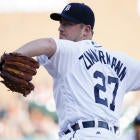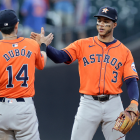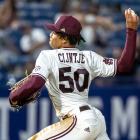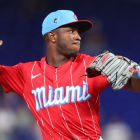It's fair to write that Jordan Zimmermann has not lived up to expectations with the Detroit Tigers. In 75 appearances, he's posted an 86 ERA+ and has allowed a home run every five or so innings -- marks far worse than the ones he notched during a successful seven-year run with the Washington Nationals that included in two All-Star Game appearances.
Whether or not Zimmermann has time to vindicate himself in the Motor City is anyone's guess, but in his first two starts of the season he's giving it a real try. Don't laugh. Zimmermann's Opening Day shutdown of the Toronto Blue Jays registered the second best game score of his Tigers tenure. His start on Tuesday against the New York Yankees tied for the 14th-best. Zimmermann, then, has began 2019 with two of his best starts in the last three-plus years.
There's no sense getting hot and bothered based on a small sample, but it is perhaps encouraging that Zimmermann's quality introduction to the new season is accompanied by a radical shift in approach. He has, to put it in baseball terms, embraced pitching backward.
Through Zimmermann's first two starts, he's thrown 61 percent breaking balls, according to Statcast. That's notable since last year he set a new career-high by throwing 49 percent. Previously, he'd thrown more than 40 percent just once in his career. Zimmermann has resorted to his offspeed-over-all approach more frequently as his starts have progressed. Per Brooks Baseball, he's thrown 48 percent fastballs his first trip through the order and less than 33 percent the rest of the way.
Zimmermann is essentially following the blueprint that helped extend James Shields's career, and is doing so at a time when baseball is more receptive to prioritizing swings-and-misses. Even if the tide hadn't shifted over the last decade, Zimmermann's breaking-ball spamming would make sense. Batters have hit better than .300 against his fastball over the last four years, and last season, they were less likely than ever to whiff on the offering. Take a look at his batting average against by year:
| Year | Fastball | Slider | Curveball |
|---|---|---|---|
2018 | .313 | .206 | .263 |
2017 | .337 | .231 | .379 |
2016 | .342 | .238 | .185 |
2015 | .298 | .231 | .188 |
Now take a look at Zimmermann's whiff rate by pitch over those same seasons:
| Year | Fastball | Slider | Curveball |
|---|---|---|---|
2018 | 9.9% | 27.5% | 28.1% |
2017 | 13.5% | 23.8% | 21.6% |
2016 | 12.6% | 24.4% | 19.8% |
2015 | 14.0% | 26.9% | 30.0% |
Zimmermann's fastball has clearly been his most hittable pitch, while his breaking balls (particularly his trademark slider) have been more likely to create outs and empty swings.
Pitching isn't as easy as looking at these numbers and reacting -- there's an interplay between pitches to consider, for example, and not everyone can throw their breaking balls for a strike. Zimmermann, though, has thus far thrown a higher percentage of strikes than at any point in his career with the Tigers. He's also missing more bats and appears to be evading more barrels. Those are all good signs for a pitcher who has struggled with suppressing hard contact in recent years.
Obviously there's a risk that the league will catch on to Zimmermann's wicked game and curb its effectiveness. There's a risk too that throwing so many sliders and curveballs will harm him physically. But Zimmermann appears willing to accept those terms and conditions -- at least so long as it helps him enjoy what's been a pleasant early-season resurgence.


















